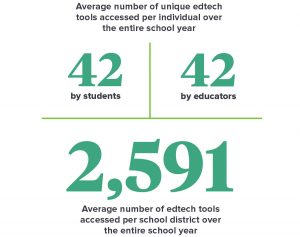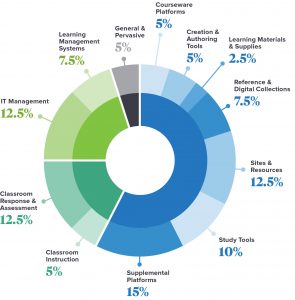Districts Using More Tech Tools Overall, But Individual Educators Taking Up Fewer, Report Finds

Schools are on the whole using slightly more technology tools than they were last year, but individual educators and students appear to have grown more selective, according to a new analysis.
Those two shifts could be explained by different forces playing out in school districts. Teachers may be looking for tech tools that can be customized to their individual needs, or they could be seeking to scale back their usage slightly because they’re overwhelmed by the resources available to them, said Karl Rectanus, senior vice president of K-12 strategy at Instructure, the organization that published the report for its sixth year.
By contrast, schools and districts continue to be taking up a broad array of tools consistently over time, he added.
The company assembles the data from usage information gathered through LearnPlatform’s Inventory Dashboard, which collected data between Sept. 1, 2022 and May, 31 2023. The report includes an analysis of more than 57 billion browser and mobile engagements across 9,000 education technology products during the year.

According to the data, K-12 institutions as a whole are accessing 1.7 percent more tools aggregated annually over the past academic year.
However, the number of unique digital solutions accessed by educators decreased by nearly 20 percent as compared to last year. That number also decreased for students by 14 percent.
In tracking usage and trends of digital tools, the report also highlights the top 40 education technology products that were used this past school year, broken down into categorical rankings, including courseware platforms, learning management systems, supplemental platforms, and resources and digital collections.
This year’s list of most-used solutions remains generally consistent with previous years, with big companies like Google Classroom, Kahoot, and Quizlet making the cut.
Additionally, more than half of the tools listed in the top 40 focus on learners and emphasize teacher-student interactivity, a signal that engagement is a critical focus for districts, Rectanus said.

Despite schools as a whole using more tech tools, that number could go down as leaders are looking to consolidate platforms and maximize efficiency, Rectanus said.
For companies working with schools, especially at a time when federal stimulus funds are set to run out near the end of next year, that means aligning themselves with districts’ key priorities when it comes to what they look for in education technology – namely, interoperability, security, personalization, and learner-focused solutions, he added.
States and districts have received a total of about $190 billion in federal stimulus money since the start of the pandemic. Districts are required to have obligated, or committed, that money by September of 2024.
“We’re seeing a contraction for individuals, be they students or teachers, because maybe they were overwhelmed, or maybe they were effectively personalizing [learning],” Rectanus said. “But the diversity of those solutions is significant in that it’s requiring organizations to manage more, even while individuals are engaging in fewer tools.”
On average, school districts accessed an average of 2,591 distinct ed-tech tools annually, according to the report. Students and educators both averaged about 42 tools this academic year.
For companies, there’s going to be more of a serious demand for ecosystems that are safe, accessible, and interoperable as districts are forced to manage a wider range of tech tools, Rectanus said.
Users will also be looking for systems that deliver some form of customized learning or service on the individual level, he added.
There may be among district leaders “further contraction [of tools], but you’ll also see them focus on increased capabilities in platforms, so that they can focus their efforts, rather than trying to manage 2,600 different individual decisions,” Rectanus said.
Three new companies joined the top 40 list this year, including GoGuardian, Securly, and Study.com – two of which are data security organizations – an indicator that districts and states are increasing attention to digital safety practices, Rectanus said.
“The ed-tech industry should focus on ensuring they’re delivering on these three areas – evidence, effectiveness, and safety,” Rectanus said, “because that’s what will drive purchasing, decision-making, and effective teaching and learning.”
Follow EdWeek Market Brief on Twitter @EdMarketBrief or connect with us on LinkedIn.
Image by Getty.
See also:
